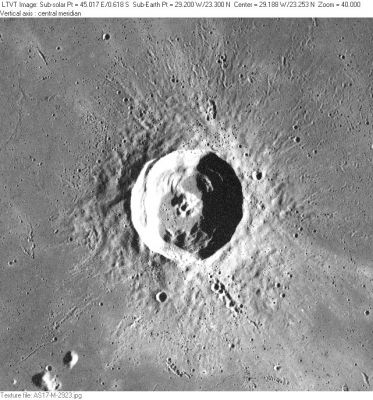Euler
Contents
Euler
|
Lat: 23.3°N, Long: 29.2°W, Diam: 27 km, Depth: 2.24 km, Rükl: 20, Eratosthenian |
Images
LPOD Photo Gallery Lunar Orbiter Images Apollo Images ASU Image of the Week (Figure 2, the second photo, which is Euler instead of Aristarchus, research Danny Caes).
Maps
(LAC zone 40D1) LAC map Geologic map LTO map
Description
Description: Elger
(IAU Directions) EULER.--The most westerly of the row of great ring-plains, which, beginning on the E. with Autolycus, and followed by Archimedes, Timocharis, and Lambert, extends almost in a great circle from the N.E. to the S.W. side of the Mare Imbrium. It is about 19 miles in diameter, and is surrounded by terraced walls, which, though of no great height above the Mare, rise 6,000 feet above the floor. There is a distinct little gap in the S. wall, easily glimpsed when it is close to the morning terminator, which probably represents a small crater. Euler has a bright central mountain, and is a centre of white silvery streaks.
Description: Wikipedia
Additional Information
- Depth data from Kurt Fisher database
Arthur, 1974: 2.24 km
Westfall, 2000: 2.24 km
Viscardy, 1985: 2.24 km
Cherrington, 1969: 0.67 km - From the shadows in AS17-M-2923, Euler is about 2350 m deep. - Jim Mosher
- Included in ALPO list of bright ray craters
- Thermal anomaly crater, implying youthful age - Moore et al, 1980
- Euler Gamma (19°30' North/ 28°30' West; south-southeast of Euler itself) is a very interesting target for lunar observers with powerful telescopes, because of the half-submerged craterlet at Euler Gamma's lower southeastern flanks. This half-submerged craterlet is described in Harold Hill's book (see bibliography below). Three orbital Hasselblad photographs made during the mission of Apollo 17 show Euler Gamma and its half-submerged craterlet. These photographs are: AS17-151-23268 , 23269 , and AS17-139-21292. Research: Danny Caes
- A very interesting close-up of Euler Gamma is included in panoramic frame AS17-P-3103 (left part of this photograph). Research: Danny Caes
- Another Apollo-photograph of Euler Gamma appeared in APOLLO OVER THE MOON; A VIEW FROM ORBIT, Chapter 5: Craters (Part 3), Figure 126 (Euler Gamma is in the lower left corner of this photograph). Research: Danny Caes
- A 35 mm Nikon photograph of Euler gamma, made during Apollo 17, is AS17-160-23991. Euler gamma and its half-submerged crater are noticeable at the lower left part of the photograph. Research: Danny Caes
- TSI = 25, CPI = 15, FI = 20; MI =60 Smith and Sanchez, 1973
Nomenclature
- Named for Leonhard Euler (pronounced Oiler) (April 15, 1707 – September 18, 1783), a pioneering Swiss mathematician and physicist, who spent most of his life in Russia and Germany. He published more papers than any other mathematician in history. Euler made important discoveries in fields as diverse as calculus and topology. He is also renowned for his work in mechanics, optics, and astronomy.
- According to Whitaker (p. 218), this name was introduced by Schröter.
- Euler E is called Firdausi on LTO 39-B3. Who was Firdausi? (Ferdowsi). See this Wikipedia-page.
- In his informal 1953 tour of Mare Imbrium, Leland Copeland referred to the group of hills and hillocks south-southwest of Euler as the Scattered Hills. Research: Danny Caes
Lothrop Hills - The Euler Group
- Lothrop Hills is another unofficial name for the region southwest of Euler (including Mons Vinogradov). This name was printed on the greenish Rand Mc.Nally moonmap and on the same moonmap in Patrick Moore's Atlas of the Universe (1983). The origin of the name Lothrop Hills is still a mystery (who was Lothrop?). For a list of much more mysterious names on these moonmaps, see Rand McNally. Harold Hill called this region The Euler group (see bibliography below). Research: Danny Caes
LPOD Articles
Bibliography
Euler and environs:
- GEOLOGIE AUF DEM MOND (J.E.Guest/ R.Greeley), seite 108, abbildung 6.1. (NASA Apollo 17 - 2923).
- APOLLO OVER THE MOON; A VIEW FROM ORBIT, Chapter 4: The Maria (Part 1), Figure 65. Chapter 5: Craters (Part 3); Figure 137. (Part 4); Figures 138 and 139.
Euler Gamma and its half-submerged craterlet:
- APOLLO 17: PRELIMINARY SCIENCE REPORT (page 28 - 28; Lunar Orbiter photograph).
- Harold Hill. A Portfolio of Lunar Drawings, page 53.
